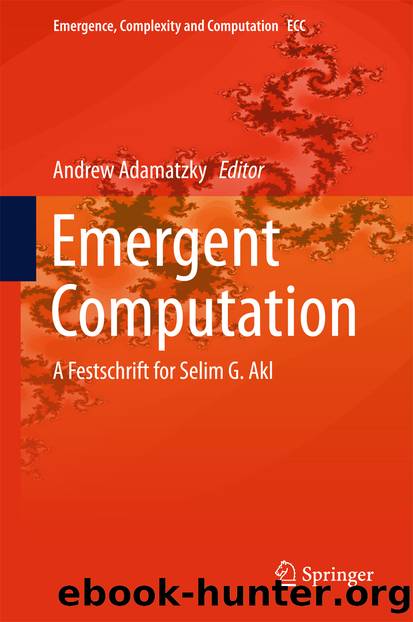Emergent Computation by Andrew Adamatzky

Author:Andrew Adamatzky
Language: eng
Format: epub
Publisher: Springer International Publishing, Cham
4 Dispersion of Mobile Sensor Networks
Mobile wireless sensor networks have a wide range of applications [33, 37] and there has been much research on this topic. The mobile sensors have the same general characteristics as in a sensor of a sensor network. Additionally, each mobile sensor has locomotion capability. One of the main reasons for using the mobile sensors is to improve the coverage of the networks. However, this leads to a very important research question. How one sensor can move so that it can maximize the coverage of the network?
Typically, a sensor is deployed in a network to cover some region of the network. The coverage of a network is defined as the area that is covered by its sensors. In different applications of MWSN, it is not possible to deploy the sensors deterministically so that they can maximize the coverage. More commonly, they are deployed randomly and the sensors are required to disperse autonomously using algorithms to maximize the coverage of the network [37]. In different applications, along with the coverage, the preservation of the connectivity is also a major concern. Once the sensors try to move by themselves, they can break the connectivity. Connectivity is an important aspect of the network as it is used to route the data among the nodes. We call this problem the Mobile Dispersion Problem.
We first discuss a cellular automaton based algorithm that maximizes the coverage of a MWSN very quickly, involves fewer sensor movements when compared with an earlier cellular automaton algorithm [48], and is simpler than other existing techniques [17, 22, 51]. Though we have not considered the energy constraints on the movement of the sensors explicitly, the number of sensor movements gives a good approximate measure of energy use and gives a good measure of the usefulness of the algorithms in practice.
In the first set-up the sensors are restricted to an area. This means that, as long as the sensors are sufficiently dispersed (the algorithm works probabilistically), most of the network stays connected. We also consider a scenario where a number of sensors are initially densely deployed and the area is (at least potentially) unbounded. Thus, the algorithm needs to explicitly ensure that the connectivity of the network is preserved.
Connectivity preservation is an important aspect of different wireless sensor networks as it is necessary to route information within the network. In the second part of this section we also consider different CA based algorithms for connectivity preserving deployment of mobile sensors [13, 16]. In our experimental set-up we first consider a “regular” square formation as an initial configuration of the network and find an optimal solution using a deterministic algorithm. Finally, we study systematically more realistic random initial deployments of sensors and for the realistic initial deployments it is not equally easy to obtain an optimal solution. We need to add features to the algorithm that try to prevent the creation of “holes” in the network and also, in this context, it turns out to be useful to consider randomized variants of the algorithm.
Download
This site does not store any files on its server. We only index and link to content provided by other sites. Please contact the content providers to delete copyright contents if any and email us, we'll remove relevant links or contents immediately.
| Computer Vision & Pattern Recognition | Expert Systems |
| Intelligence & Semantics | Machine Theory |
| Natural Language Processing | Neural Networks |
Algorithms of the Intelligent Web by Haralambos Marmanis;Dmitry Babenko(7852)
Hadoop in Practice by Alex Holmes(5660)
Jquery UI in Action : Master the concepts Of Jquery UI: A Step By Step Approach by ANMOL GOYAL(5512)
Life 3.0: Being Human in the Age of Artificial Intelligence by Tegmark Max(4507)
Functional Programming in JavaScript by Mantyla Dan(3723)
The Age of Surveillance Capitalism by Shoshana Zuboff(3422)
Big Data Analysis with Python by Ivan Marin(3008)
Blockchain Basics by Daniel Drescher(2890)
The Rosie Effect by Graeme Simsion(2708)
WordPress Plugin Development Cookbook by Yannick Lefebvre(2602)
Hands-On Machine Learning for Algorithmic Trading by Stefan Jansen(2517)
Applied Predictive Modeling by Max Kuhn & Kjell Johnson(2478)
Dawn of the New Everything by Jaron Lanier(2438)
Test-Driven Development with Java by Alan Mellor(2375)
The Art Of Deception by Kevin Mitnick(2297)
Data Augmentation with Python by Duc Haba(2222)
Rapid Viz: A New Method for the Rapid Visualization of Ideas by Kurt Hanks & Larry Belliston(2195)
Human Dynamics Research in Smart and Connected Communities by Shih-Lung Shaw & Daniel Sui(2178)
The Infinite Retina by Robert Scoble Irena Cronin(2174)
